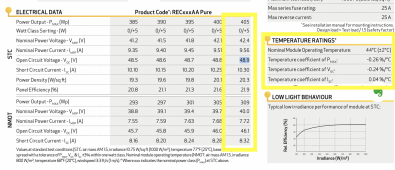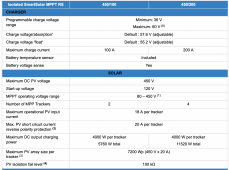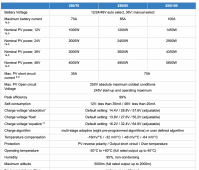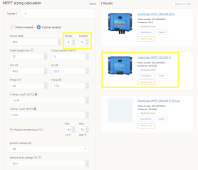I'm a total noob, and would appreciate any comments on this.
I am figuring out which charge controller to use and came across these two from Victron.
Smartsolar MPPT RS 450/100 versus Smartsolar MPPT 250/100 Tr. (both spec sheets are attached below)
For example when I use the Victron MPPT calculator with REC Alpha Alpha Pure Series 405 watt panels (spec sheet attached below)
The MPPT RS 450/100 can handle a max of 8s2p = 16 panels
The MPPT 250/100 Tr can handle a max of 4s9p = 36 panels
Questions/comments/issues:
Thanks for the help.
Spec sheets and more are attached below:
REC Alpha Pure Series 405 watt

MPPT RS 450/100 spec sheet (middle column), w/ MPPT calculator screenshot


compared to MPPT 250/100 Tr spec sheet (right most column), w/ MPPT calculator screenshot


I am figuring out which charge controller to use and came across these two from Victron.
Smartsolar MPPT RS 450/100 versus Smartsolar MPPT 250/100 Tr. (both spec sheets are attached below)
For example when I use the Victron MPPT calculator with REC Alpha Alpha Pure Series 405 watt panels (spec sheet attached below)
The MPPT RS 450/100 can handle a max of 8s2p = 16 panels
The MPPT 250/100 Tr can handle a max of 4s9p = 36 panels
Questions/comments/issues:
- Can someone please explain to me why the MPPT 250/100 is able to intake so much more power but can only output 100 amps? And why is this beneficial or not beneficial versus the MPPT RS 450/100 which uses less than half the panels yet can output the same 100 amps?
- Is the MPPT 250/100 not as efficient at converting the power?
- Running wires, fuses, fuse holders, etc for 8s2p seems to be a lot less work than 4s9p and much cheaper. after listing out all the additional parts necessary, the MPPT RS 450/100 comes out to being cheaper.
- Any other comments would be much appreciated.
Thanks for the help.
Spec sheets and more are attached below:
REC Alpha Pure Series 405 watt

MPPT RS 450/100 spec sheet (middle column), w/ MPPT calculator screenshot


compared to MPPT 250/100 Tr spec sheet (right most column), w/ MPPT calculator screenshot






